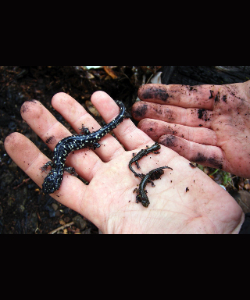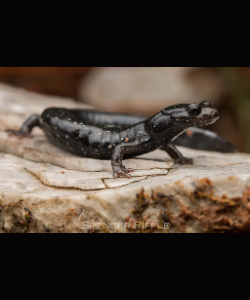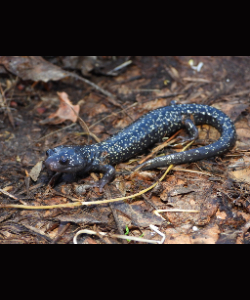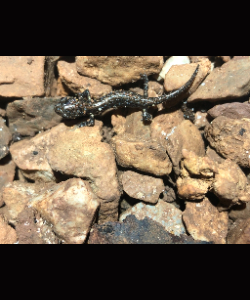Shasta Black Salamander (Aneides iecanus)
Description: Adults measure 2 to 3 3/4 inches long from snout to vent, and up to 5.5 inches total length. A large robust plethodontid salamander with two nasolabial grooves and 14 - 16 well-defined costal grooves. Adults are black with moderate to heavy white speckling on the head, body, and tail. The venter is greyish black. Males have a broader head than females. Young are similar to adults - black with moderate to heavy white speckling.
Habitat: Occurs in mixed deciduous woodland, lowland coniferous forests, coastal grasslands. Found under rocks near streams, in talus, under damp logs, and other objects.
Range: The known range of this species so far is only in Shasta County, in an area around Mt. Shasta but it might also occur south in Tehama and Glenn counties. "The species is known from north central and western Shasta County, California, as well as extreme southeastern Siskiyou County in the vicinity of Castle Crags, California, but the identity of scattered specimens from the western margin of the Sacramento Valley to the south has not been determined. Aneides iecanus occurs at elevations ranging between about 300 m (near the surface of Lake Shasta) to over 1,000 m (in the Castle Crags area). Populations along the inner margins of the Coast Ranges in western Tehama and Glenn Counties ... may be assignable to Aneides iecanus, but further surveys including morphological and genetic analyses are needed." )
Found in these States:
CA
Diet: Diet consists of a variety of small invertebrates, including millipedes, ants and termites. As salamanders grow larger, they eat fewer, but larger prey items.
Reproduction: Reproduction is terrestrial. Courtship and breeding behavior is not well known. Breeding males have a well-developed mental gland. Females probably lay from 8 - 25 eggs in moist cavities belowthe ground in July and August. Eggs are attached by peduncles. Females stay with the eggs until they hatch. Young develop completely in the egg and hatch fully formed.
Status: Listed as Endangered, as this species has an extent of occurrence (EOO) of 3,329 km2, it occurs in five or fewer threat-defined locations, and there is continuing decline in the extent and quality of its habitat as well as an impending future threat that could lead to substantial habitat loss.
Taxonomy: Described by Edward Drinker Cope in 1883, it was later synonymized with the speckled black salamander (A. flavipunctatus). However, a 2019 taxonomic study confirmed it as being a distinct species, and again split it.
»» Kingdom: Animalia - Animals
»» Phylum: Chordata - Chordates
»» Subphylum: Vertebrata - Vertebrates
»» Class: Amphibia - (Amphibians)
»» Order: Caudata - Salamanders
»» Family: Plethodontidae - Lungless Salamanders
»» Genus: Aneides
»» Species: Aneides iecanus - Shasta Black Salamander
This article uses material from the Wikipedia article "Shasta Black Salamander", which is released under the Creative Commons Attribution-Share-Alike License 3.0. Content may have been omitted from the original, but no content has been changed or extended.
|













